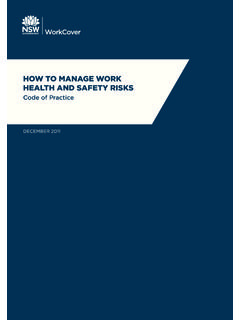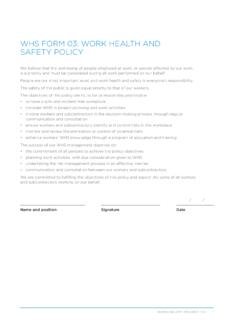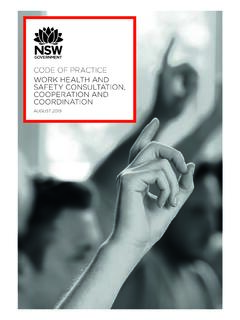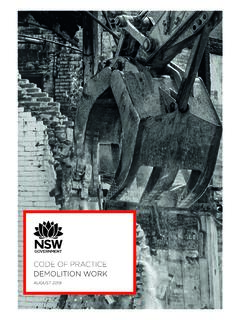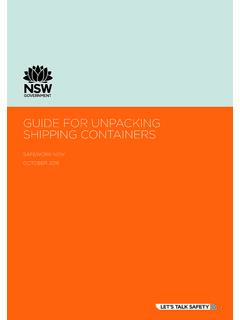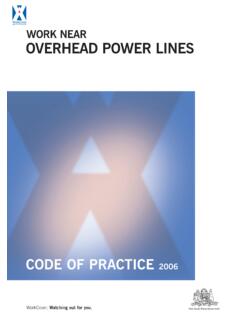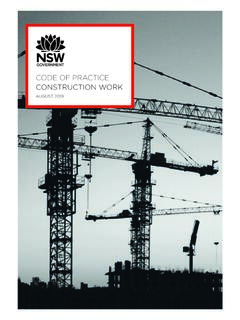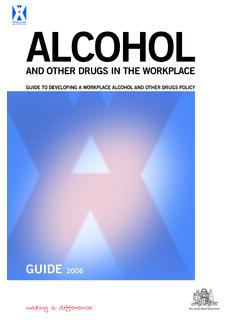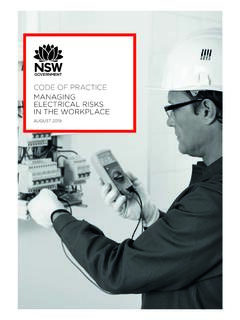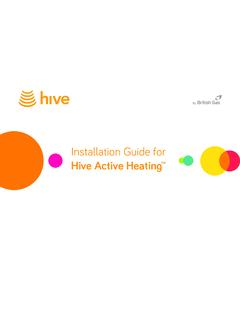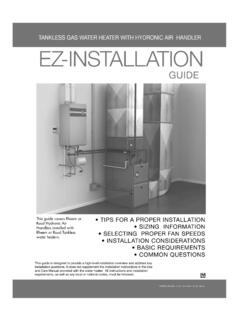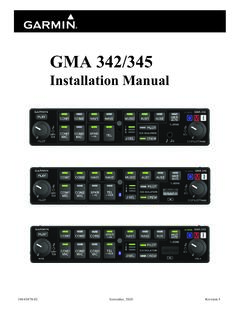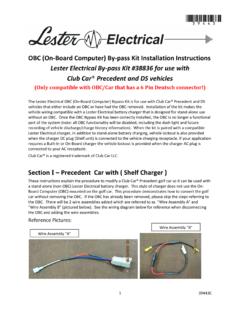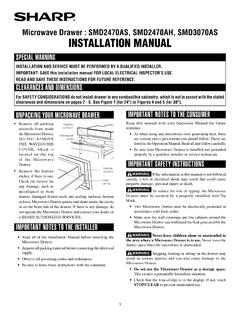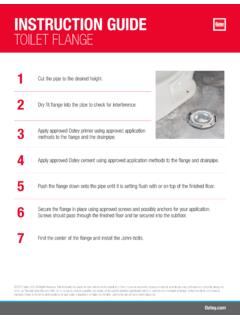Transcription of Guide to safe solar panel installation - SafeWork NSW
1 Guide TO SAFE solar panel INSTALLATIONSAFEWORK NSWFEBRUARY 2021 DisclaimerThis publication may contain information about the regulation and enforcement of work health and safety legislation in NSW. It may include some of your obligations under some of the legislation that SafeWork NSW administers. To ensure you comply with your legal obligations you must refer to the appropriate on the latest laws can be checked by visiting the NSW legislation website publication does not represent a comprehensive statement of the law as it applies to particular problems or to individuals or as a substitute for legal advice. You should seek independent legal advice if you need assistance on the application of the law to your material may be displayed, printed and reproduced without amendment for personal, in-house or non-commercial No.
2 SW09388 SafeWork NSW, 92 100 Donnison Street, Gosford, NSW 2250 Locked Bag 2906, Lisarow, NSW 2252 | Customer Experience 13 10 50 Website Copyright SafeWork NSW 0221 CONTENTS1. Introduction 42. Requirements for businesses in the solar industry 43. Planning for the installation 54. Safe work method statements 65. Hierarchy of control 66. Safe installation of the solar pv system 77. Site set-up 88. Accessing the roof Installing fall prevention Fall prevention devices Preventing falls through brittle/fragile roof material including skylights Work positioning systems Fall arrest systems 149. Electrical risks 1610. Other risks Working in ceiling voids Handling Asbestos Information, training, instruction and supervision 1911.
3 Further information 20 Appendix 1: Example of the solar installers safety checklist 214 SafeWork NSW1. INTRODUCTIONThis Guide has been developed by SafeWork NSW to provide the solar industry clear direction on controlling risk. The Guide should be read in conjunction with the Work Health and Safety Act 2011 & Work Health and Safety Regulation 2017 and relevant Codes of solar photovoltaic systems (PV) exposes workers to risks of serious injury or death. Installers must manage the risks to maintain a safe place of NSW is the State s work health and safety regulator. We promote compliance with work health and safety (WHS) legislation by providing information, education and assistance on WHS matters to improve industry outcomes and ensure a fair and level playing REQUIREMENTS FOR BUSINESSES IN THE solar INDUSTRYThe solar installation industry includes system designers, manufacturers, solar retailers, installation contractors and clients.
4 Under the work health and safety legislation these are known as a person conducting a business or undertaking (PCBU). A person conducting solar installations may hold multiple duty s under the legislation, for example the solar retailer may also be the DesignersSolar photovoltaic (PV) system designers must consider the risks to worker health and safety for the installation and maintenance of the system. Where reasonably practicable systems should be installed a safe distance from fall and electrical hazards and allow for a safe means of Manufacturers solar PV system manufacturers must ensure that the system is manufactured to be without risk to health and safety of persons. For example, they must ensure adequate testing of the components, and that adequate information is provided to those installing the system as well as the users of the RetailersSolar retailers market and sell solar PV systems.
5 This may include advice on the system that best meets the customer needs. solar retailers may allocate installation work in-house or subcontract the work to contractors. If the sale of solar panels includes installation , the business must have systems in place to ensure the salesperson has sufficient knowledge to identify the safety controls that will be required to be costed in the quotation and incorporated into the installer s safe work method statement. installation contractors must have sufficient knowledge, qualifications, equipment, skills and procedures to comply with safety practices. solar retailers must have an adequate system and site audit to confirm that installation contractors are undertaking work InstallersInstallation staff or contractors are involved in the direct installation of solar PV systems.
6 Installers must have sufficient knowledge, qualifications, equipment, skills and safe systems of work to comply with the work health and safety legislation. Installers must implement adequate supervision to ensure that workers are undertaking work installation includes the installation of the solar components themselves, such as the panels and mounting rails. It also includes the installation of electrical equipment and TO SAFE solar panel INSTALLATION3. PLANNING FOR THE INSTALLATIONYou must ensure that you have inspected the site prior to installation . This should be completed before providing a quotation, which will ensure that the quote includes the cost of required safety control measures such as temporary edge protection, scaffolding, EWPs, exclusion zones, access to the roof or mechanical lifting aids such as panel inspecting the site, you can then develop a site-specific safe work method statement which is also a legal common hazards and risks are listed below: Working at heights: access (both people and equipment) falls from heights falling objects slippery glazed tiles or tiles with algae or moss deposits roof pitch/slope damaged roofing/fragile roofs/brittle roofing/skylights.
7 Electrical: discharge from uninstalled panels electrical wiring, electrical fittings and electrical equipment contact with overhead power lines or electrical cables, those located in the ceiling space under the roof. Asbestos: inhalation of asbestos fibres fragile/brittle roofing. Weather conditions: time of installation wet, cold, icy, windy or hot days. Hazardous manual tasks: handling/moving panels handling solar panel mounting you work on solar installations: plan before accessing the roof use fall protection make sure all workers are trained assess and control electrical risks avoid live work use electrical equipment safely comply with relevant standards6 SafeWork NSW4. SAFE WORK METHOD STATEMENTSThe installation of solar PV systems requires businesses to undertake high-risk construction work as it usually involves the risk of a person falling more than 2 metres and work near live electrical installations.
8 You must ensure that the safe work method statement (SWMS) prepared for high-risk construction work includes the specific hazards, risks and control measures for the site you are working on. The SWMS should be developed in consultation with working out the suitable control measures, consideration must be given to the hierarchy of controls. This ensures the highest level of protection is provided to protect the health and safety of workers and the public who may be affected by the work. You can access a sample SWMS template from the SafeWork NSW website ( ) by typing safe work method statement in the search HIERARCHY OF CONTROLThe most important step in managing risks involves eliminating the hazard, or if that is not reasonably practicable, minimising the risks so far as is reasonably practicable.
9 When selecting controls you must consider various options and choose a control that most effectively eliminates the hazard or minimise the risks. This may involve a single control measure or a combination of different controls put together to provide the highest level of ways of controlling risks are ranked from the highest level of protection and reliability to the lowest as shown in figure 1. This is known as the hierarchy of control and a business must work through this hierarchy when managing certain risks, for example falls from heights, electrical and manual handling 1: Safety hierarchy of controlFigure 1: Safety hierarchy of controlELIMINATIONR emove the hazard completely. Eliminating the hazard is the most effective way to manage it is not practical to eliminate a hazard, risks must be one or more of the followingENGINEERINGC hange the designSUBSTITUTE THE HAZARDR eplace the hazard with something saferISOLATE THE HAZARDS eparate the hazard from peopleMinimise any remaining risk by using administrative controlsADMINISTRATIONH ealth and safety procedures and policies - safe work procedures, staff trainingIf risks remain, the possible impact on people must be controlled using PROTECTIVE EQUIPMENT (PPE) - safety glasses, hard hats, protective clothingThis is the least effective way to manage risks7 Guide TO SAFE solar panel INSTALLATION6.
10 SAFE installation OF THE solar PV SYSTEMWhen conducting solar installations there are specific requirements that must be complied with during the solar PV system installation must be carried out by a licenced electrician experienced in the specific installing the solar panels: use the identified control measures for eliminating or minimising the risk of falls from heights, and other hazards like asbestos follow the safe work procedures for installing the solar panels and supporting structures including following the manufacturer instructions ensure manufacturer requirements are followed when installing mounting points for the solar panels framing, considering the highest wind speeds for the region (refer to :2002 Structural design actions Wind actions) ensure that external wiring is protected from UV rays ensure that mechanical protection of cables is provided in accordance with AS/NZS 3000 Australian/New Zealand Wiring Rules and AS/NZS :2017 Electrical installations Selection of cables ensure that risks associated with manual handling are is the electrician s responsibility to ensure a copy of the Certificate of Compliance Electrical Work (CCEW) is provided.
